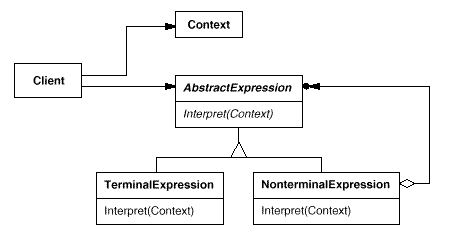Applied Design Patterns with Java
Behavioral :: Interpreter (243) {C ch 18}
Applicability
Use the Interpreter pattern when when there is a language to interpret, and you can represent statements
in the language as abstract syntax trees. The Interpreter pattern works best when:
- the grammar is simple. For complex grammars, the class hierarchy for the grammar becomes large and
unmanageable. Tools such as parser generators are a better alternative in such cases. They can interpret expressions
without building abstract syntax trees, which can save space and possibly time.
- efficiency is not a critical concern. The most efficient
Interpreters are usually not implemented by interpreting parse trees directly but by first translating
them into another form. For example, regular expressions are often transformed into state machines. But even then, the
translator can be implemented by the Interpreter pattern, so the pattern is still applicable.
Structure

Participants
- AbstractExpression (RegularExpression) declares an abstract Interpret operation that is common to all nodes
in the abstract syntax tree.
- TerminalExpression (LiteralExpression) implements an Interpret operation associated with terminal symbols
in the grammar, and an instance is required for every terminal symbol in a sentence.
- NonterminalExpression (AlternationExpression, RepetitionExpression, SequenceExpressions): one such class is required
for every rule R ::= R1 R2 ... Rn in the grammar, maintains instance variables of type AbstractExpression for each of the symbols
R1 through
Rn, implements
an Interpret operation for nonterminal symbols in the grammar. Interpret calls itself recursively on the variables
representing R1
through Rn.
- Context contains
information that's global to the Interpreter.
- Client builds (or
is given) an abstract syntax tree representing a particular sentence in the language that the grammar defines. The abstract
syntax tree is assembled from instances of the NonterminalExpression and TerminalExpression classes, and invokes
the Interpret operation.
Catalog Behavioral Prev Next

